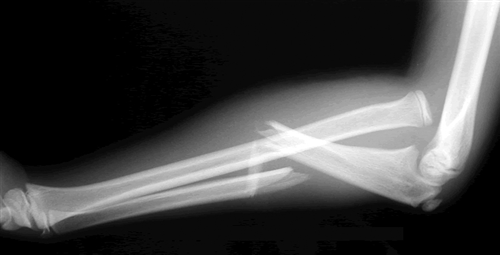


Reduction and stability of the DRUJ are then assessed with forearm rotation if the reduction is stable the forearm can be immobilized in supination for 4 to 6 weeks ( 11, 12). Moreover the thumb abductors can contribute to further shortening of the radial side of the wrist.Īnatomic restoration of the length and alignment to the radius is essential in the management of these injuries ( 2, 8– 10). The brachioradialis shortens the fragment on the ulna and pronator quandratus also pulls the distal fragment volar and proximal to the ulna. The hand acts as a volar deforming force on the distal fragment. Galeazzi fracture cannot be controlled with closed treatment because of the deforming force of the brachioradialis, pronator quadratus, thumb extensor and abductors described by Hughston ( 8). After 6 weeks pins were removed and joint showed stable. Because of the instability of the left DRUJ even after 4 weeks immobilization in splint, we stabilized this joint with percutaneous radioulnar pinning. In our patient, lateral x-ray of the left wrist, demonstrated dislocation of the ulnar head relative to the radius. They list 4 reliable radiographic signs of DRUJ disruption as: basal fracture of ulnar styloid widening of joint space of the DRUJ as shown on anteroposterior x-ray dislocation of the radius relative to the ulna as shown on a lateral x-ray and a shortening of the radius of more than 5 millimeters. Moore et al believe that the exact clinical and radiological criteria for Galeazzia fractures have not yet been clearly established ( 7). Because of rare occurrence of this injury and presence of multiple fractures and dislocations there is possibility of pitfalls in the operative treatment of these cases ( 13).įalling down on outstretched hand with pronation of left side could cause distal radius fracture, DRUJ dislocation, radial head dislocation, ulnar open fracture, humerus fracture and radial nerve laceration at arm fracture site. To the best of our knowledge the occurrence of combined Monteggia-Galeazzi fracture on one side and Monteggia-distal radius fracture on the other side in the same patient have never been reported. There are few reports of combined Monteggia with distal radius fracture. Ten cases of combined Monteggia and Galeazzi fracture have been reported (8 adults and 2 childrens) ( 4, 5, 6, 13). Galeazzi fracture is fracture of the distal radial shaft with DRUJ dislocation. At the time of the last visit 18 months after trauma, the elbow, forearm, and wrist motion were all evaluated ( Table 1).Īccording to Bado ( 3), Monteggia lesion includes radiohumeral dislocation associated with fracture of the ulna at any level. The patient returned to work 9 months after the accident. Six months after the trauma the healing of the fractures was completed and the patient recovered his wrist extension power ( Fig. Twelve weeks after the primary trauma the ulnar fracture in the left forearm did not progressed to union as well as that of the right side, Thus plating and bone grafting were performed on the left side. Consequently a closed reduction of the DRUJ was performed in the operating room and the ulna pinned to the radius (the pins were removed 6 weeks later). When the forearm splints were removed after 4 weeks, the left distal radio ulnar joint (DRUJ) seemed unstable and dislocated by forearm supination. The radial lacerated nerve at the level of the fracture was repaired with open reduction of the femoral fracture. Three days after the trauma when the patient's general health had stabilized, open reduction of the humerus fracture with radial nerve exploration was performed. A: Right forearm after reduction of distal radius fracture, radial head dislocation and open ulnar fracture, B: Left forearm after percutaneus pining of distal radioulnar joint.īilateral long arm splint was applied.


 0 kommentar(er)
0 kommentar(er)
